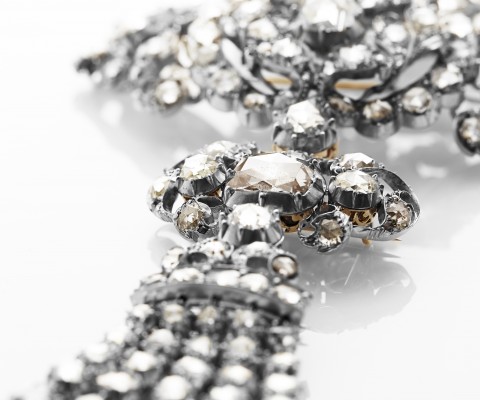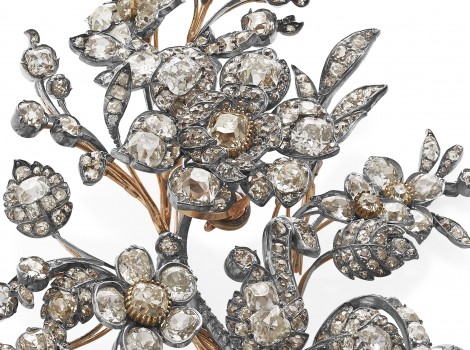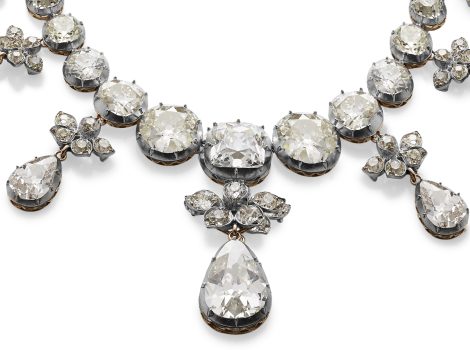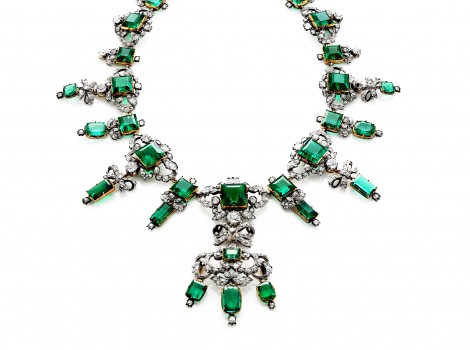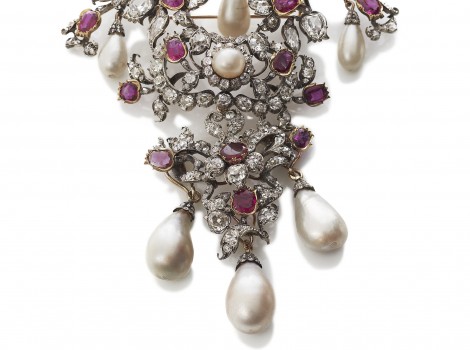The rose-cut diamond set
The mysterious crown jewel set
The rose-cut diamond set was long shrouded in mystery – how was this impressive jewellery set worn? Today, the set is described as a necklace and two brooches. It was created in 1840 by the jewellery firm C.M. Weishaupt & Söhne of Hanau in Hesse, Germany, for Christian VIII’s consort, Queen Caroline Amalie (1796–1881).
Not a necklace
The rose-cut diamond set did not appear to be included on any of the preserved invoices from the jewellery firm C.M. Weishaupt & Söhne, who created the set in its current form between 1840 and 1842. For decades, the set was regarded as a long necklace with a brooch, but eventually, it was linked to an invoice dated 29 March 1842 for a belt (‘gürtel’), which was the original intended use of the necklace. The rose-cut diamond set was designed to be worn around a corseted waist with the large pendant, previously viewed as a brooch, in the middle. The pendant can also be broken up, so that the individual pieces can be worn separately as smaller brooches.
Stitched onto the dress
Although the Danish queens continued to wear corsets as late as the time of the First World War in order to attain the fashionable hourglass figure, the belt was not designed to reach all the way around the waist. Tiny loops on the belt and at the ends of it suggest that it was stitched onto the dress. In Queen Caroline Amalie’s time, in addition to the narrow waist, fashionable dresses often included a long train. Fastened on the back, the train would cover this part of the waist, so the belt was only meant to decorate the front of the dress. Queen Lovisa (1851–1926) was aware that the set was intended as a belt, as illustrated by a large portrait that shows her wearing it around her waist. Queen Lovisa took great interest in the crown jewels and used loose pearls and precious stones to create additional pieces of jewellery for the collection. Today, these pieces are on display at the Amalienborg Museum.
Diamonds like rosebuds
Rose-cut diamonds have a special cut that makes the individual stones resemble rosebuds. Most of the stones originally belonged to Christian VI’s unmarried sister, Princess Charlotte Amalie (1706–1782). Like her sister-in-law Sophie Magdalene (1700–1770), she specified in her will that her brilliant-cut and rose-cut diamonds should be included in the crown jewels.
The rose-cut diamond set during the reign of HM Queen Margrethe
HM Queen Margrethe rarely wore the rose-cut diamond set during her reign. On a few occasions, HM Queen Margrethe wore the brooch, including at a gala performance at the Royal Danish Theatre celebrating her 50th birthday. The belt that is part of the rose-cut diamond set has not left the Treasury at Rosenborg since Queen Ingrid wore it as a necklace around 1950.
Photo Iben Kaufmann

 Dansk
Dansk
 English
English
 Deutsch
Deutsch

